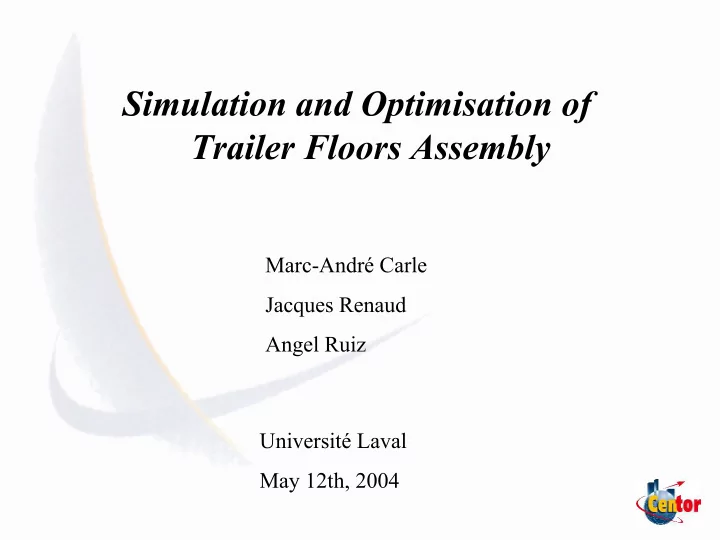

Simulation and Optimisation of Trailer Floors Assembly Marc-André Carle Jacques Renaud Angel Ruiz Université Laval May 12th, 2004
Presentation outline • Problem definition • Methodology • Heuristics • Results • Conclusion
1. Problem • Manually-assembled Trailer floors • Batten lengths ranges from 8 to 70 inches • Once assembled, battens are fixed with glue • Assembly chain fed by conveyor (4 battens / second) Operators have only 1,5 second to choose the right batten and to position it.
Performance criterion • Industry quality standard: At least 3 inches between two joints on adjacent battens • Shortest euclidian distances are used. joint joint distances
Performance criterion • What we call an « error percentage » is: Nb of joint pairs in error × 100 Nb of joints
2. Hypothesis • Battens arrive one by one in the assembly process; • It is impossible to move a batten once it is fixed to the floor; • Batten lengths are random, but the random distribution of batten lengths is known; • Batten lengths follows a stationary stochastic process;
Research objectives: • Reproduce the assembly process • Develop assembly rules to mechanize trailer floor assembly process • Evaluate the resulting floor quality
3. Methodology • Simulation-based approach – Generation of a population of battens; – Assembling the floor(s) using a specific rule; • Assembly rules are in fact constructive heuristics; • All « assembly rules » refer to processes that can be mechanized;
3. Heuristics • A very simple rule: – Put the incoming batten at the first available space, i.e., without reference to performance criterias. • Two heuristics: – Assembly « line by line » – « Parallel Assembly »
Assembly heuristics • « Line-by-line » Assembly
Assembly heuristics • « Line-by-line » Assembly
Assembly heuristics • « Line-by-line » Assembly
Assembly heuristics • « Line-by-line » Assembly Etc…
Assembly heuristics • Parallel Assembly
Assembly heuristics • Parallel Assembly
Assembly heuristics • Parallel Assembly
Assembly heuristics • Parallel Assembly
Assembly heuristics • Parallel Assembly Etc…
What else can we do within 0,25 second? • Three heuristics: – SWAP – Rejection – Temporary storage
Assembly heuristics • « SWAP » heuristic
Assembly heuristics • Rejection heuristic
Assembly heuristics • Rejection heuristic
Assembly heuristics • Rejection heuristic
Assembly heuristics • Temporary storage
Assembly heuristics • Temporary storage
Assembly heuristics • Temporary storage
Assembly heuristics • Temporary storage
Assembly heuristics • Temporary storage
4. Simulation results Results for the two « basic » heuristics Statistics Line-by-line Parallel Nb of floors 750 750 Error % 14,59% 14,43%
4. Results SWAP heuristic: Heuristic Error % Nb of Floors Variance Line-by-line 14,59 1,051 750 SWAP 14,24 0,704 80
4. Results Rejection heuristic: Difference Rejection Heuristic Nb floors Error % with manual % process Line-by-line 750 14,59 % --- 9,6% Rejection 80 2,88 % 13,4% -2,12% (max=1) Rejection 80 0,75 % 15,5% -4,25% (max=2) Rejection 80 0,37% 16% -4,63% (max=3) Rejection 80 0,26% 16,3% -4,74% (max=5)
4. Results Rejection heuristic Performance vs Number of battens rejected 16 14 12 10 Error % 8 6 4 2 0 0 1 2 3 4 5 6 Max consecutive rejected battens
4. Results Temporary storage heuristic Nb of Difference with Heuristic Error % Floors manual process Line-by-line 750 14,59 % 9,61 % Storage (1) 80 2,19 % -2,81 % Storage (2) 80 0,52 % -4,48 % Storage (3) 80 0,15 % -4,85 % Storage (5) 80 0,02 % -4,98 %
5. Conclusions • We developed simple yet powerful heuristics for this problem. • Parallel, line-by-line and SWAP heuristics produce solutions of poor quality. (about 14% of errors) • Both Rejection and Temporary storage heuristics produce solutions of good quality. (Less than 2% of errors) • These heuristics can be easily mechanized
Questions?
Recommend
More recommend